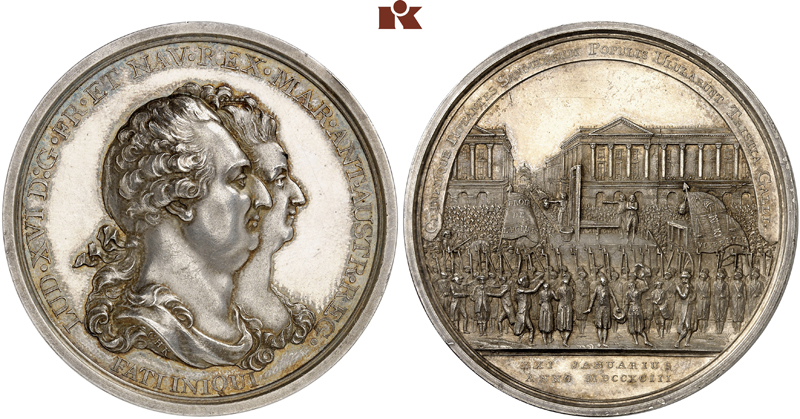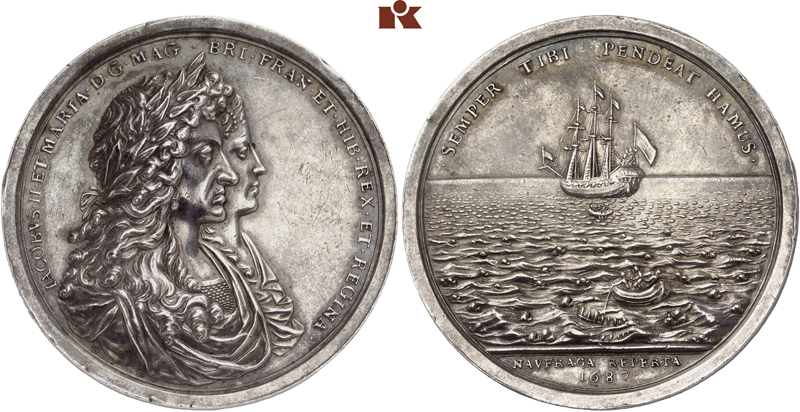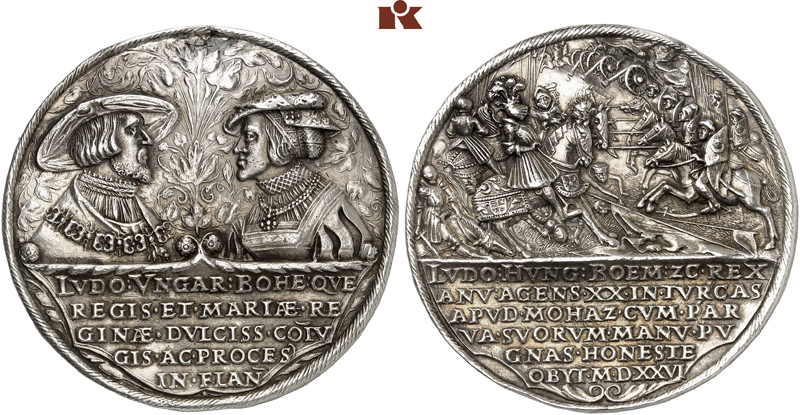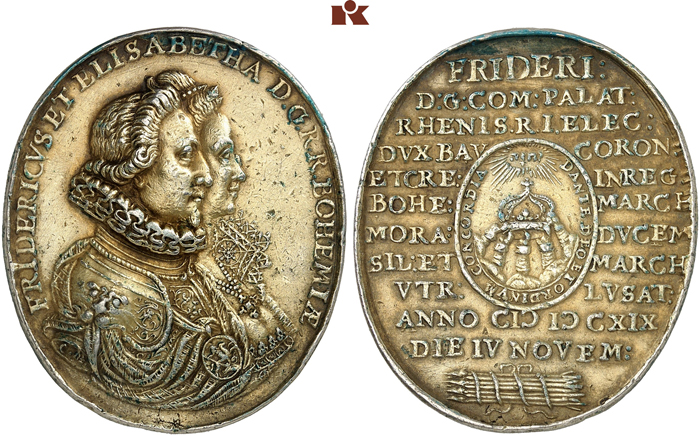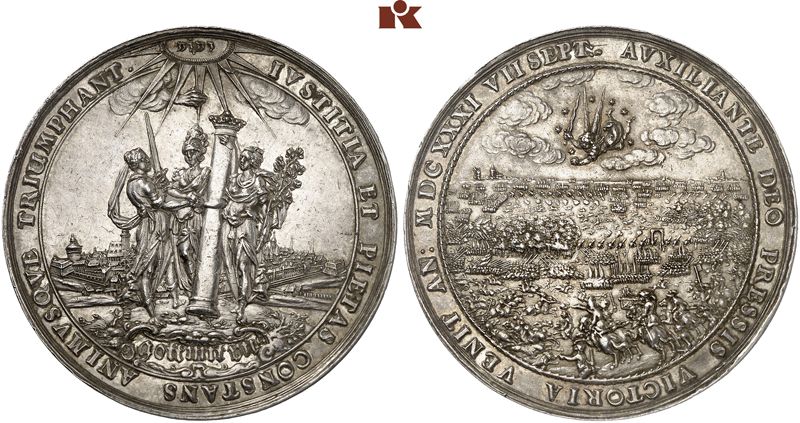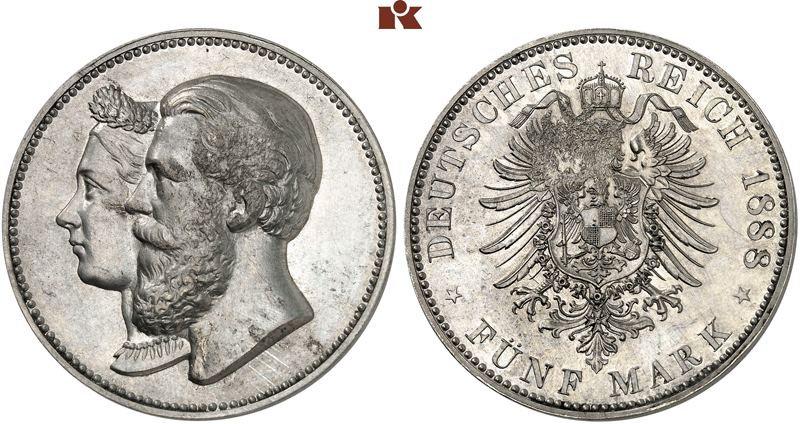Preview of our eLive Premium Auction 401: Multiple Portraits - A Private Collection from Westphalia
21. Januar 2024
On 5 and 6 February 2024, another part of the private collection from Westphalia with “multiple portraits” will be on offer at www.elive-auction.de. You can participate in the online sale and bid on the medals of this extensive collection from the comfort of your own home. In this preview, we present the history of five examples. Please keep in mind that we focused on rarer pieces and that the estimates of these medals are correspondingly high. However, starting prices begin at 50 euros, which means that there is something on offer for every budget. And all pieces have a fascinating history that is worth to be explored!
A King Mounts the Scaffold
On the morning of 21 January 1793, Citizen Louis Capet was taken to the square that is known as Place de la Concorde today. Roughly 20,000 people had gathered to witness the execution of the former king of France. They stared at the guillotine that was exactly where the large obelisk stretches skyward today. Right behind it was the base of the former equestrian statue of Louis XIV. The monument itself had already been pulled down in August 1792. You can see all these details on a medal created in commemoration of the execution of the former royal couple, probably in London. Responsible for the design was the Darmstadt engraver Conrad Heinrich Küchler, who had fled to Great Britain. On the medal’s obverse, he depicted the former royal couple. Marie Antoinette was beheaded on the same square as Widow Capet in the October of the same year. This medal forms part of a comprehensive media campaign aimed at mobilizing the forces of the European bourgeoisie, which the monarchs of all countries were to rally for their fight against the revolution.
William Phips Finds His Treasure
Forget about Pirates of the Caribbean! Numismatics has much more fascinating stories to tell, such as that of William Phips, which is presented by this medal. Born in the Massachusetts Bay Colony, Phips came from humble origins. He completed an apprenticeship as ship’s carpenter and won the heart of a young lady from the bourgeoisie. With her help, he tried to enlarge his father-in-law’s business and turn it into a shipping company. But instead of transporting valuable timber on the maiden voyage of his first schooner, Phips evacuated fellow citizens from the burning city. His shipyard also fell victim to the flames and he had to start anew with nothing but a single ship.
Phips became a salvage specialist. Many ships foundered at the time and took their valuable cargo to the bottom of the sea. Phips recovered the goods and made quite a living by doing so. It so happened that the Royal Navy knew of a Spanish wreck off the coast of Santo Domingo, which had sunk during the annual silver transport from the old world to the new. The Navy commissioned Phips to recover the silver. He succeeded – of course only after the government had ceased funding his efforts and even shortly before private funds for the project had been depleted. The successful treasure hunter brought silver worth 300,000 pounds to England. The public purse was delighted to receive the major share of it. But there was enough left for Phips to become a rich man himself, and King James II elevated him to nobility.
The obverse of the medal shows this English ruler alongside his wife Mary of Modena. It had been created on behalf of the king by the royal mint as a gift. Phips, his officers and the supporters of the undertaking also received a specimen.
The reverse shows Captain Phips’ vessel, in the foreground a small rowing boat, on which Phips tries to catch treasures with a hook. The Latin circumscription taken from Ovid alludes to this: Always let your hook be hanging.
Tu felix Austria nube
At first glance, the battlefield on this medal does not have anything to do with a wedding or good fortune. It shows the clash of cultures: Christian Hungarians on the left, identifiable by their armor, are battling the Ottomans, whose shields clearly bear a crescent. The Hungarian cavalry faces not only the sipahi, but also a powerful artillery that could not be matched by the Hungarians.
King Louis II was killed at the Battle of Mahács along with most of his nobility. The Turks conquered a large share of his territory. However, it was a third who rejoiced. Due to a marriage contract, the Habsburg Ferdinand I annexed rich Bohemia and a part of Hungary. He laid claim to the entire possessions of Louis II. However, he was only able to assert this claim once the Ottoman Empire had been defeated. Only a few battles in history had as far-reaching consequences as the Battle of Mohács on 29 August 1526.
The Winter King
In theory, Bohemia was an elective monarchy and its estates had the freedom of choosing their king. In practice, however, they had exclusively elected Habsburg candidates since 1526. Therefore, it was almost a declaration of war when they decided against recognizing Ferdinand II, who had already been crowned as King of Bohemia, after the Defenestration of Prague and the death of Emperor Matthias. Instead, they opted for Frederick V of the Palatinate. He was known as an ardent advocate of the Protestant cause, and the Bohemians hoped that his wife Elizabeth, the daughter of King James I of England and Scotland, would secure them the support of her father. Frederick was crowned on 4 November 1619 at St. Vitus Cathedral, an event that is commemorated by the mercury-gilded silver medal offered in the eLive Premium Auction. Its obverse shows the ruler, who was mocked as the “Winter King”, with his wife. On the reverse, the Bohemian estates emphasize that the coronation was a joint decision, blessed by God: the crown is held by many hands. Below is the proverbial bundle of arrows that cannot be broken unless the bond is untied and the individual arrows are destroyed one by one.
In fact, Frederick V and the Bohemian estates misjudged the balance of power. Frederick had to flee from Prague as early as on 9 November 1620 after his army had been defeated at the Battle of White Mountain.
PR in the 17th Century
The engraver Sebastian Dadler (1586-1657) was one of the greatest artists among those who used innovative designs to propagate the Protestant cause. We could draw your attention to a dozen of exciting details on this medal, created on the occasion of the Battle of Breitenfeld near Leipzig on 17 September 1631. To stay within the scope of this preview, we had to choose a single one of them.
You can see three women standing under a sun inscribed with the name of God. A hand from the cloud blesses them, granting divine grace. The woman on the left holds a sword, indicating to any educated person at the time that she must be the personification of justice. The woman at the center bears a column, presenting herself as steadiness. The woman with the laurel branch on the right symbolizes the fear of God, which means that the representation can be read as follows: if justice, steadiness and the fear of God come together, they are blessed by God and their cause will triumph. Of course, the Protestant Dadler assigned all these virtues to the Protestant Gustavus Adolphus and thus celebrated the victory at Breitenfeld as a divine judgement in favor of the Protestants.
Emperors Are Only Human, Too
In the March of 1887, the German crown prince Frederick consulted a Berlin laryngologist because he – a heavy smoker – was constantly suffering from hoarseness. This was a problem for someone who had to speak to large crowds without the convenience of a microphone. His hoarseness turned out to be laryngeal cancer, and neither German nor English physicians had any remedies for it at the time. By then, Frederick’s father William I had already celebrated his 90th birthday. His end was foreseeable. Therefore, the Berlin mint had already created several designs for new coins that were to be issued on behalf of the new ruler. For example, a die with the portrait of the brand-new emperor and his wife. The dies were never used to strike actual coins. Frederick’s reign was probably too short for that. His father died on 9 March 1888. Frederick himself died on 15 June 1888, two days after suffering through the official reception of King Oscar II of Sweden. “Lear to suffer without complaining” is a motto attributed to him today.
Catalog Orders
To order a catalog contact our customer service via phone: +49 541 / 962020; fax: +49 541 / 9620222; or via e-mail: service@kuenker.de. You can access the auction catalogs online at www.kuenker.de. If you want to submit your bid from your computer at home, please remember to register for this service in good time.


